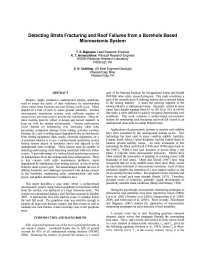Mining Publication: Detecting Strata Fracturing and Roof Failures from a Borehole Based Microseismic System
Original creation date: July 2008
Modern, highly productive underground mining operations need to assure the safety of their workforce by understanding where major strata fractures and roof failures could occur. Mines depend on a host of tools to assess ground instability. In-mine microseismic monitoring systems with sufficient number of sensors have also been used to provide this information. These in-mine systems must be robust in design and moved regularly to keep up with the mining advancement. System performance issues depend on maintaining ever increasing cable runs, preventing component damage from mining activities (scaling, blasting, etc.) and avoiding signal degradation due to interference from mining equipment (fans, trucks, electrical equipment, etc.). A potential solution is to use a surface-based monitoring system having sensors placed in boreholes above and adjacent to the underground mine workings. These sensors must be capable of detecting and locating strata fracturing associated with rock failure events. A great advantage of a surface-based monitoring system is its independence from the underground mine infrastructure. There is less concern with cable maintenance problems, signal degradation by interference from mining activity, or loss of power from the mine's power grid. The disadvantages include the cost of drilling boreholes and challenges associated with placing sensors in the boreholes, maintaining radio communication and solar power, and public interference (vandalism, etc.). This paper describes a case study where a surface-based microseismic system, using triaxial geophones in boreholes drilled from the surface, was deployed at a large limestone mine. The system was operational during a roof fall that occurred in October 2007. It detected the first rock fracture event 17 minutes before the rock fall event. The geophone array was sensitive enough to identify all large rock fracture, impact, and blast events as well as medium-size rock fracture events occurring close to the geophone array.
Authors: TS Bajpayee, AT Iannacchione, SR Schilling
Conference Paper - July 2008
NIOSHTIC2 Number: 20034275
Proceedings of the 27th International Conference on Ground Control in Mining, July 29 - July 31, 2008, Morgantown, West Virginia. Peng SS, Mark C, Finfinger GL, Tadolini SC, Khair AW, Heasley KA, Luo-Y, eds., Morgantown, WV: West Virginia University, 2008; :313-318
See Also
- Characteristics of Mining-Induced Seismicity Associated with Roof Falls and Roof Caving Events
- An Evaluation of Microseismic Activity Associated with Major Roof Falls in a Limestone Mine: a Case Study
- Forecasting Roof Falls with Monitoring Technologies - A Look at the Moonee Colliery Experience
- Local Earthquake Tomography for Imaging Mining-Induced Changes Within the Overburden above a Longwall Mine
- Mapping Hazards with Microseismic Technology to Anticipate Roof Falls - A Case Study
- The Relationship of Roof Movement and Strata-Induced Microseismic Emissions to Roof Falls
- Seismic Detection of Trapped Miners Using In-Mine Geophones
- Temporal Imaging of Mine-Induced Stress Change Using Seismic Tomography
- Three-Dimensional Time-Lapse Velocity Tomography of an Underground Longwall Panel
- Time-Lapse Tomography of a Longwall Panel: A Comparison of Location Schemes
- Page last reviewed: 9/21/2012
- Page last updated: 9/21/2012
- Content source: National Institute for Occupational Safety and Health, Mining Program


 ShareCompartir
ShareCompartir
